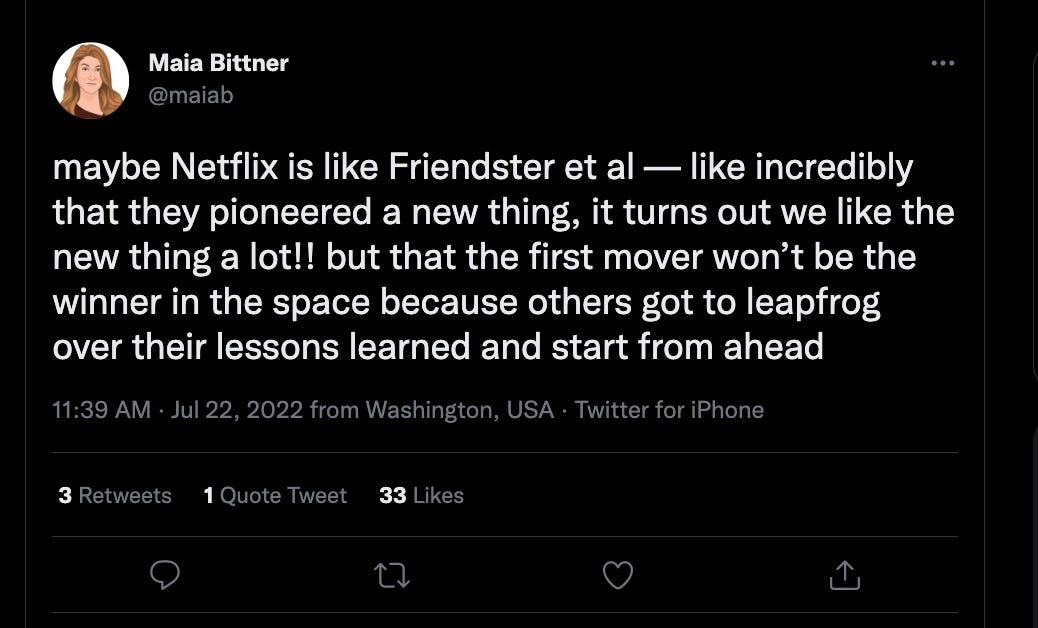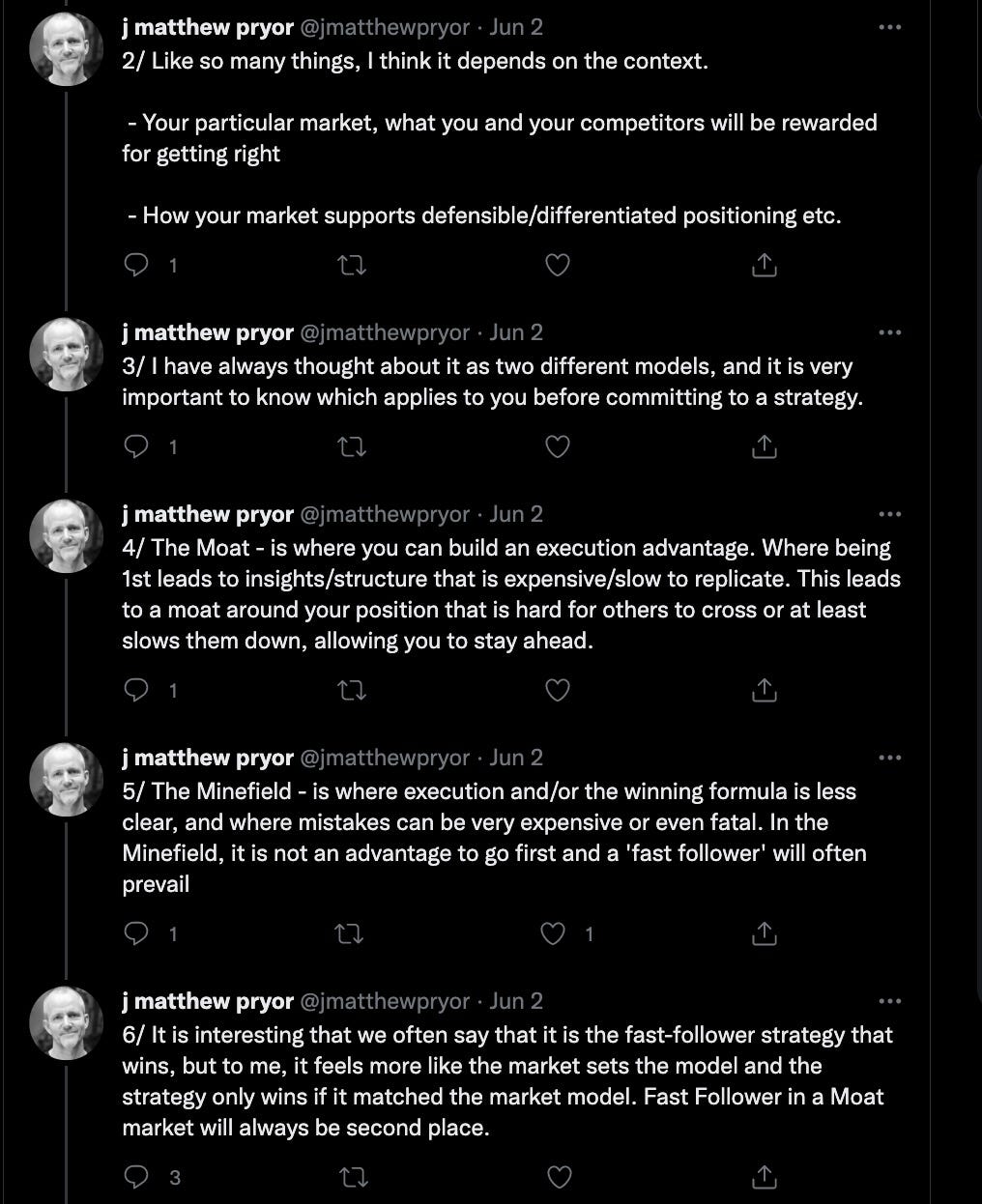The boogeyman of first mover advantage
Prime Future 113: the newsletter for innovators in livestock, meat, and dairy
Netflix launched their streaming service in 2007 and has 220.7 million subscribers.
Disney+ launched late 2019 and now has 221 million subscribers.
Hmm, seems like Disney could be to Netflix what….
Facebook was to MySpace or Friendster, both early versions of social media.
DoorDash was to Webvan, the grocery delivery company that raised a boat load of venture capital, IPO’d, & went out of business in the dot com bust.
Walmart was to Piggly Wiggly, inventor of the modern supermarket format.
The idea of first mover advantage gets all the love, but I'm increasingly convinced of the power of second mover advantage.
My favorite example of second mover advantage in agtech is AgVend, who were second movers to Farmers Business Network's first move in bringing ag retail online.
Farmers Business Network, a farmer-to-farmer network and e-commerce platform, was founded in 2014. My understanding at the time was that they were setting out to create transparency in the ag inputs market in two ways, 1) by capturing actual price data from farmers in exchange for access to other farmers’ input price data, and 2) by creating a direct to farmer model that cut out the traditional ag retailer by bringing the transaction of purchasing inputs to the FBN marketplace.
They've since raised $929 million in venture funding and expanded into several verticals. But in 2018, FBN had only raised $194 million in venture funding and was still squarely in the business of disrupting the traditional ag retail model.
The story goes that the CEO of FBN stood up in a room full of ag retailers and said, "you think I'm the boogeyman? I'm worse than the boogeyman."
That quote sounds like a badly written line from the movie The Social Network, but more importantly that was the backdrop against which Alexander Reichart, CEO of AgVend, and his cofounder began to map their plans as the second mover in this still emerging category of ag retail e-commerce.
I recently caught up with Alexander and asked, how do you think about the role of second mover advantage in the AgVend story? Here are some insights he shared:
"When starting AgVend, we knew there was a missing link in the basic digital infrastructure around commerce, communications, payments, and research about products. We looked at other models in the markets, mostly compared to FBN. But the premise we disagreed on was that they came in and said there's no reason this should be a 3 step model, we can go direct to grower and we can cut out the retailer. After working with the retailers and listening to growers, and understanding the fundamentals of logistics in the industry, we decided there's a real need for the retailer. Its not efficient and there's a lot of fat, but we didn't say let's throw the baby out with the bath water and cut out the retailer.
We realized the Amazon for ag would serve only a very small segment of transactional customers so the ag retailer is who you need to be empowered. Second mover advantage was super helpful to learn from their model and created a foil; Amol (FBN CEO) rattled the cage for retailers which prompted retailers to look for other options."
Another interesting thing about AgVend is that a couple of years into the company's life, they pivoted from a modified marketplace to a platform for retailers, allowing retailers to white label the software so their customers can access their own grower portal. They describe this as building "the technology that keeps the most innovative ag retailers, distributors, and suppliers connected to their customers."
Where the FBN model was about disrupting ag retailers with technology that cut off the retailer-grower relationship, the AgVend model was about helping ag retailers access technology to enhance the retailer-grower relationship.
I also asked Alexander, how do you think about business model innovation?
"Listen to your customers, build a good business, and then scale. If you just shut up and listen, people will tell you. If you don't go in there thinking you know better and you don't go in undervaluing the person you're speaking with, they'll tell you what the problems are.
Since we can build anything, as far as software, the hardest part of the job is figuring out what we should build. There's always a shiny new opportunity, and we think 'let's go chase it'. But then we ask the question, why are we uniquely positioned to win in that market? If we can't answer that question, then we look to find the best players to partner with and build really strong collaborations."
My hypothesis is that not only was FBN actually good for AgVend, but the formation of AgVend was likely good for FBN. In April 2022 articles were published that FBN would be filing to IPO soon, so obviously they've found ways to make their model work.
The truth is that very few markets are really winner-take-all markets.
So its not surprising that multiple models can work, especially in a market as large as North American ag retail.
There seem to be two primary benefits to second mover advantage:
Second mover gets to learn from the first mover- both the right moves of what's worked and wrong moves of what hasn't worked or doesn't seem likely to work long term.First mover gets the benefit to the newly created category of a second mover -competition can grow the pie of the category and the perception that the category has staying power.
To add a bit more nuance to this discussion, here’s a recent thread:
Matthew goes on to explain his hypothesis about the context of market structure:
So maybe first mover isn’t always best, but neither is being the second mover always best. Sounds about right!
In the spirit of learning out loud, I will reluctantly share a story about my naivete and why this whole discussion lives rent free in my mind…
One of the first companies I wanted to start but chickened out on was in 2015, I heard friends talk about wanting to buy part of a beef but they didn't have the freezer space to buy a whole or half carcass. So what if we could build a model where you would ship meat directly to the customer on some sort of predictable schedule? And hey, people are talking about local so what if it was locally sourced beef?
I was already questioning the viability of the business model I had in mind and then I saw that some company called CrowdCow had raised several million dollars. They were using all the same words I was. THIS WAS IT, THEY HAD BEAT ME TO THE PUNCH AND WON THE GAME.
I share this because when I first got into agtech ~2015, I thought that once you saw announcements about a company raising venture capital that that was it - the category had been won. The game was over. LOL & cringe, of course that couldn't be further from the truth.
Obviously that joke is on 2015 Janette who didn’t move forward on that venture because if the D2C market is still in its early days today, it was embryonic way back then. And probably the best thing for the category would have been multiple companies getting funded, with second and third and fourth movers innovating to find profitable business models that could scale. Live and learn :)








Jeanette, how are you? Great read! thanks a lot.
My half a cent (not even two cents!) An additional analysis I would make, is on stakeholders in the value chain. Nothing happens in a vacuum, as they say. So business models should always take into account who´s business are you affecting along the value chain. May be in a positive way or negative one. Adoption of your tech may be hindered or leveraged, depending on this. Moats may be built, by engaging key stakeholders.
Last one: as agriculture has long business cycles (measured in seasons) it seems difficult for a disruption to occur, as it takes several business cycles for it to occur. It gives time for other players to detect, analyse and react.